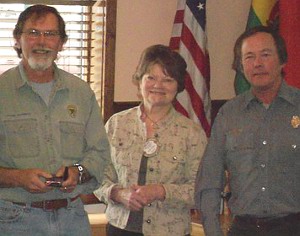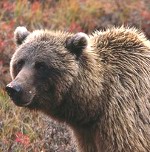Rotary learns about
grizzly bears
|
|
October 13, 2011 |
 |
|
Idaho Fish
and Game Senior Biologist Wayne
Wakkinen, left, Rotary president Wilma
Devore, and IDFG Conservation Officer
Greg Johnson. |
| Rotary Club
photo |
At their meeting Tuesday, October 4, Boundary
County Rotarians learned more about a critter
that's made a lot of news lately in the county,
the grizzly bear, and they heard it from two of
the people in the county who likely know more on
the subject than anyone else in the world.
Idaho Fish and Game Conservation Officer and
Rotarian Greg Johnson, who's been patrolling the
county's back country for almost 30 years, and
IDFG senior wildlife biologist Wayne Wakkinen,
who's spent more than 20 years focused mainly on
grizzly bear recovery, were the meeting's guest
speakers.
Johnson spoke of the two local cases that have
garnered national attention, two incidents
compounded by other grizzly bear/human
encounters that occurred this year. He spoke of
the May incident in which Jeremy Hill, reacting
to three grizzly bears on his property and the
threat they posed, shot and killed a two-year
old male grizzly bear and faced federal
prosecution for his attempt to protect his
family, as well as the September 16 incident
that left both a hunter, Steve Stevenson, dead,
a grizzly bear, mistaken for a black bear, dead
as well, and a young man, Ty Bell, 20, forced to
live the rest of his life with the knowlege that
in trying to save his friend by shooting the
bear, he caused his friend's death.
According to Johnson, most bear encountersin
Boundary County occur on the west side of the
Kootenai River in the Selkirk Mountain recovery
zone, where it's estimated to hold about 80
grizzlies. The east side of the river, he said,
has approximately 50 grizzly bears.
 |
| According to
senior IDFG Senior Fish and Game
Biologist Wayne Wakkinen, conditions are
improving for the grizzly bear, but by a
very slim margin. |
"There is a perception by many residents that
there are grizzly bears everywhere," Wakkinen
told those in attendance. "Density studies have
shown that there are between 50 and 72 grizzly
bears inhabiting the entire Selkirk Mountain
ecosystem including Idaho and British Columbia.
This trend represents about a three-percent
poplulation growth. There are less bears in the
Cabinet-Yaak ecosystem east of the Kootenai
River."
He described many of the techniques used to keep
track of the bears, and described their life
cycles, saying that breeding females,
typicallybeginning at age six or seven, have
offspring every third year, and that cubs
typically stay with their mother for two years.
He said that more of the bears are coming to
lower elevations, and warned that people should
recognize the trend, and take steps to avoid
enticing hungry bears.
"There are no laws or ordinances in Idaho to
prevent the feeding of grizzly bears," he said.
"Consequently, there have been some cases in
which grizzlies have had to be destroyed because
of the encroachment onto and into populated
areas."
Despite this, he said, there are more grizzly
bears living in this neck of the woods, and for
the first time in a long time, reproduction is
ahead of mortality. |
|
Questions or comments? Click
here to
email! |
|
|
|
|

